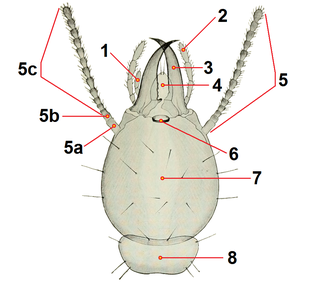
The Formosan termite is a species of termite local to southern China and introduced to Taiwan, Japan, South Africa, Sri Lanka, Hawaii, and the continental United States.
Postelectrotermes militaris, the up-country tea termite, is a species of drywood termite of the genus Postelectrotermes. It is native to India and Sri Lanka. It is a serious pest of tea.
Neotermes greeni, is a species of drywood termite of the genus Neotermes. It is native to India and Sri Lanka. It closely resembles Postelectrotermes militaris. It is a minor pest of tea in Sri Lanka, and major pest of mango in India.
Kalotermes jepsoni, is a species of damp wood termite of the genus Kalotermes. It is native to India and Sri Lanka. It usually prefers to live in dead and decaying wood, but sometimes can be seen in live wood. It is a major pest of tea in Sri Lanka.
Glyptotermes ceylonicus, is a species of damp wood termite of the genus Glyptotermes. It is endemic to high elevations Sri Lanka. It is a pest of dead and decaying wood of Hevea, Theobroma, Ficus, and Acacia species.
The Low-country tea termite,, also known as Low country live wood termite, is a species of damp wood termite of the genus Glyptotermes. It is endemic to high elevations Sri Lanka. It is a major pest of tea in low country area of Sri Lanka.

Coptotermes ceylonicus, is a species of subterranean termite of the genus Coptotermes. It is native to India and Sri Lanka. It is a common wood destroying termites, which damage to logs, woodens structures of both natural and man-made. It is a pest of many economically valuable trees such as Hevea brasiliensis and Camellia sinensis, and also an inhabitant of Anacardium occidentale, Cocos nucifera, Ficus fergusonii, Gliricidia sepium, Grevillea robusta, Madhuca longifolia, Tamarindus indica and Theobroma cacao.
Coptotermes emersoni, is a species of subterranean termite of the genus Coptotermes. It is native to India, Sri Lanka, and Vietnam. Though it is a wood destroying termite, it was first found from an electrical wire case in the National Museum of Colombo.
Coptotermes gaurii, is a species of subterranean termite of the genus Coptotermes. It is native to South India and Sri Lanka. It is a serious pest of tea in Sri Lanka.
Heterotermes indicola, is a species of subterranean termite of the genus Heterotermes. It is native to tropical India, Pakistan and Sri Lanka but has extended its range into the subtropics and warm temperate areas of the Himalayan foothills to altitudes of about 2,000 m (6,600 ft). It causes damage to timber in buildings and is one of the most destructive termites in urban and agricultural areas in the world. Soldiers are about 4.1-4.9mm long. Extracts of garlic and Calotropis procera are known to have termiticidal effects on H. indicola.
Termitogeton umbilicatus, is a species of subterranean termite of the genus Termitogeton. It is endemic to Sri Lanka and can be seen in forests, plains, hills and human vegetation of higher elevations.
Prorhinotermes flavus is a species of subterranean termite of the genus Prorhinotermes. It is native to India, Sri Lanka, Andaman Islands and Nicobar Islands. It is found in coastal areas such as mangroves. It shows both dampwood and subterranean termite behavior, nesting in dead trees but foraging on soil as a typical subterranean termite. It is not known to be a pest.
Odontotermes ceylonicus, is a species of termite of the genus Odontotermes. It is native to India and Sri Lanka. Though nests in the ground, they never construct termitaria. It attacks many dead, diseased rotten plant roots and wooden buildings. It is a major pest of sugarcane and a secondary pest of tea.

Odontotermes horni, is a species of termite of the genus Odontotermes. It is native to India and Sri Lanka. It attacks many dead, decaying trees and fertilized soil. Though nests on ground, they do not construct a termitaria. It is a pest of tea, coconut and sugarcane.
Odontotermes koenigi, is a species of termite of the genus Odontotermes. It is native to India and Sri Lanka. It is a pest of tea.
Speculitermes sinhalensis, is a species of termite of the genus Speculitermes. It is native to India and Sri Lanka. It was first found from Vavuniya. They are typical subterranean soil humus feeding termites, which can be found under logs, decaying trees, rocks.
Nasutitermes ceylonicus, is a species of termite of the genus Nasutitermes. It is found in Sri Lanka. It is a pest of tea and coconut. It damages numerous wooden constructions, and timber in buildings.
Nasutitermes horni, is a species of termite of the genus Nasutitermes. It is found in Sri Lanka. It is not considered as a pest, although they are abundant in coconut plantations and forests.
Trinervitermes rubidus, is a species of mound building termite of the genus Trinervitermes. It is native to Sri Lanka.


